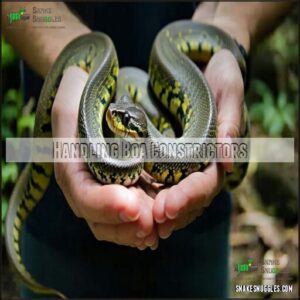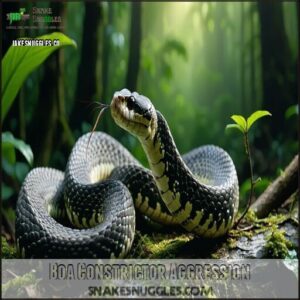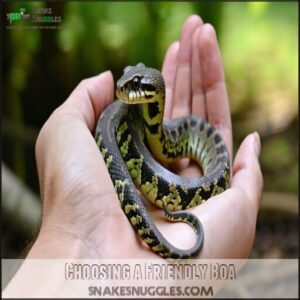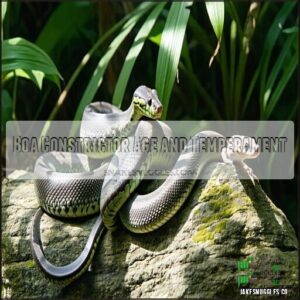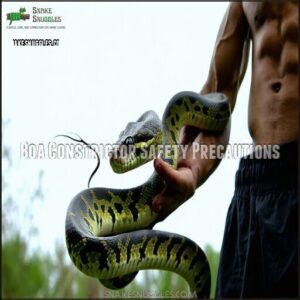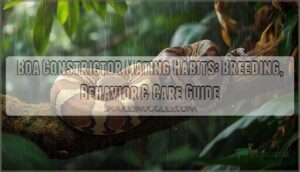This site is supported by our readers. We may earn a commission, at no cost to you, if you purchase through links.
 You’ll find boa constrictors are generally docile reptiles that calm down with regular, proper handling.
You’ll find boa constrictors are generally docile reptiles that calm down with regular, proper handling.
Their temperament varies based on individual personality, age, and previous experiences. When handling your boa, always support its body weight and avoid quick movements that might startle it.
You’ll want to wash your hands before and after handling to prevent disease transmission and remove food scents that could trigger a feeding response. Like most reptiles, boas need time to adjust to new environments, so give them 5-7 days to settle in before attempting to handle.
Mastering their body language can be your secret weapon for stress-free interactions.
Table Of Contents
- Key Takeaways
- Boa Constrictor Temperament
- Handling Boa Constrictors
- Boa Constrictor Aggression
- Boa Constrictor Fear Signs
- Choosing a Friendly Boa
- Boa Constrictor Handling Tips
- Boa Constrictor Habitat Needs
- Boa Constrictor Age and Temperament
- Boa Constrictor Safety Precautions
- Boa Constrictor Friendliness
- Frequently Asked Questions (FAQs)
- Do boa constrictors like to be handled?
- Is a boa constrictor aggressive?
- What to do if a boa is constricting you?
- Are boas good for handling?
- How do boas interact with other pets?
- Can boa constrictors recognize their owners?
- Do boas enjoy being petted or touched?
- How do boas communicate with humans?
- Can boa constrictors be trained?
- Conclusion
Key Takeaways
- You’ll find most boa constrictors have a naturally docile temperament, but individual personalities can vary based on genetics, handling experience, and environmental factors.
- You should always support your boa’s full body weight when handling, move slowly and deliberately, and limit sessions to 10-15 minutes 2-3 times weekly to build trust.
- You’ll need to recognize your boa’s body language – hissing, tight coiling, or rapid tongue flicking indicate stress, while slow, smooth movements signal comfort.
- You must create a proper habitat with appropriate temperature (75-95°F gradient), humidity (60-70%), and hiding spots to reduce stress and promote healthier temperament.
Boa Constrictor Temperament
You’ll find that boa constrictors are generally calm and even-tempered, making them a favorite among experienced reptile keepers.
However, their behavior can vary based on factors like handling, environment, and individual personality, so understanding these nuances is key to building trust.
Factors Influencing Temperament
Boa constrictor temperament depends on genetics, early handling, and individual variation.
Snake genetics shape traits like docility, while early experiences influence trust.
Proper snake care quality, including health and enclosure design, helps reduce stress.
Each boa has a unique personality—some are shy, others curious, making every snake truly one-of-a-kind and guaranteeing a calm companion when these factors are understood.
Environmental Factors and Stress
A snake’s environment can make or break its mood.
Stress signals, like hissing or coiling, often stem from poor environmental factors.
To manage snake stress, focus on these essentials:
- Enclosure Size: Spacious enough for movement.
- Temperature Gradient: Warm and cool zones.
- Humidity Levels: 60-70% is ideal.
- Substrate Choice: Comfortable and clean.
- Hiding Spots: Reduce anxiety.
Nutrition and Dietary Factors
A balanced diet is key to your boa’s temperament. Choose prey size based on their age and girth—too large, and digestion struggles; too small, and they’ll stay hungry.
Feeding frequency varies; juveniles eat weekly, adults biweekly. Supplements fill gaps in feeder nutrition, but avoid overfeeding to prevent obesity.
Always provide fresh water—hydration is just as critical as proper nutrition. Captive boas benefit from frozen-thawed prey for safety. A balanced diet is essential for overall health.
Handling Boa Constrictors
Handling a boa constrictor takes patience and a steady hand.
Start with short sessions a few times a week, gradually increasing as it gets comfortable. Always provide proper support—one hand near the head, the other under its body.
Reading signals like hissing or muscle tension helps you avoid bites. Speak softly, move slowly, and never grab its tail.
A good boa handling guide emphasizes building confidence through calm interactions. Remember, handling frequency matters—consistent practice keeps your snake relaxed and trusting.
Boa Constrictor Aggression
Understanding boa constrictor aggression starts with recognizing their body language and triggers. While these snakes are typically calm, stress or mishandling can bring out defensive behaviors like hissing or striking.
Signs of Aggression
Now that you know how to handle your boa properly, you’ll want to recognize when they’re showing aggression.
Watch for these warning signs: a tightly coiled body with the head raised in defensive postures, rapid tongue flicking, and loud hissing sounds.
Your boa might also maintain striking distance, pull back into an S-shape, or exhibit biting behavior when feeling threatened.
Body language like puffing up their throat or tightening muscles indicates stress signs.
Remember, snake aggression isn’t personal—it’s communication, and by spotting boa constrictor aggression early, you’ll keep both yourself and your scaled friend safer.
Causes of Aggression
Now that you can spot aggressive signals, let’s explore what triggers them. Your boa constrictor’s defensive behavior often stems from specific stressors in their environment or handling routine.
Common boa constrictor aggression triggers include:
- Too-small enclosures that make your snake feel trapped
- Incorrect temperature or humidity causing physical discomfort
- Shedding irritability when their skin is sensitive
- Poor handling techniques or startling your snake
- Health issues that create pain or distress
During mating season or when food scents are present, even normally docile boas may show increased aggressive behavior. Understanding these triggers helps prevent stressful encounters.
Poor husbandry, such as inadequate hides, can also lead to aggression, but proper snake husbandry can help reduce defensive behaviors.
Boa Constrictor Fear Signs
You’ll need to recognize your boa constrictor’s fear signals—like hissing, rapid tongue flicking, or tightly coiled posture—to prevent stress and potential defensive behaviors.
When you notice these warning signs early, you can adjust your handling approach and create a calmer environment for your scaly friend, making both your lives much more comfortable.
Recognizing Fear Behavior
While aggression signals a direct threat, fear in boa constrictors manifests differently.
You’ll notice rapid flicking of the tongue, muscle tension, and defensive coiling when your boa feels anxious. Hissing sounds often accompany these stress signals, especially when the snake feels cornered.
Watch for erratic movements or retreating behavior—these anxiety indicators suggest your boa needs space. A fearful boa may flatten its head or body against the enclosure floor.
Learning to read this body language helps prevent defensive behavior that could escalate to striking. Remember, a relaxed boa moves slowly with smooth, confident motions.
Reducing Fear and Stress
Through consistent handling, you’ll gradually reduce your boa constrictor’s fear responses.
Create calm environments by minimizing noise and sudden movements around their enclosure. Start with short, gentle handling sessions, increasing duration as your snake shows comfort.
Watch for stress signals like rapid tongue flicking or tight coiling, and return them to their safe enclosure if needed.
Positive reinforcement comes from providing proper temperatures and hiding spots. Many owners find that handling their boa after dark, when they’re naturally active, leads to more relaxed interactions.
Remember, patience builds trust with these impressive reptiles.
Choosing a Friendly Boa
You’ll find that selecting a boa with the right temperament is essential for a rewarding reptile relationship, as individual personalities can vary from shy and reserved to curious and outgoing.
When visiting a breeder or reptile shop, you’ll want to observe how the snake responds to gentle handling and interaction, looking for one that shows calm behavior rather than excessive defensive posturing or striking attempts.
Tips for Selecting a Boa
When selecting a boa constrictor, five essential factors can make all the difference between bringing home a friendly serpent or a stressed one.
- Choose captive-bred boas from reputable breeders who handle their snakes regularly
- Look for clear eyes, smooth scales, and an alert demeanor as health indicators
- Consider size expectations—an 8ft snake needs an 8x2x2ft enclosure minimum
- Request an initial interaction to assess the boa’s temperament before purchase
- Research specific morphs, as some variations may have different temperaments
Remember, a well-chosen boa is likely to become a docile, manageable companion for decades.
Handling and Interacting With Boas
When interacting with your boa, establish a consistent handling routine of 10-15 minutes, 2-3 times weekly.
Establish a routine of gentle, consistent handling for 10-15 minutes, 2-3 times weekly, to build trust with your boa.
Boas can sense your emotions, so approach with calm confidence. Watch their body language—relaxed muscles and slow tongue flicks indicate comfort.
Start with short sessions and gradually increase handling duration as trust builds. Use positive reinforcement by returning them to their enclosure when they’re still calm.
Never handle during shedding or within 48 hours after feeding. Remember, each boa constrictor has unique preferences—some enjoy frequent interaction while others prefer limited handling.
Your patience will be rewarded, and understanding that each boa has unique preferences is key to a successful interaction.
Boa Constrictor Handling Tips
You’ll need to support your boa’s body properly with both hands, moving slowly and deliberately to prevent triggering their defensive instincts.
Consistent handling sessions of 10-15 minutes will help build trust between you and your snake, making each interaction more relaxed and enjoyable for both of you.
Safe Handling Techniques
Now that you’ve chosen your boa, let’s focus on how to handle it safely. Always approach your boa constrictor with a calm, deliberate movement to avoid startling it.
Support your snake’s body properly—one hand behind the head and the other supporting its weight. Never handle a boa alone if it’s longer than 5 feet.
Reading your snake’s signals is critical; watch for rapid tongue flicking or muscle tensing. Some keepers utilize a specialized handling equipment for added safety.
Start with short, gradual introduction sessions of 10-15 minutes. Remember the cardinal rule: keep boas away from your neck. These safe handling techniques prevent stress for both you and your snake.
Building Trust With Boas
Now that you’ve mastered safe handling techniques, establishing trust with your boa constrictor requires patience and understanding their unique temperament.
Your boa will gradually become more comfortable with handling when you:
- Create a safe environment free from loud noises and sudden movements
- Use gentle approaches, allowing the snake to scent you before touching
- Maintain consistent interaction schedules (10-15 minutes, 2-3 times weekly)
- Recognize and respect their body language signals indicating stress
- Offer positive reinforcement by ending sessions before they become anxious
Reading your boa’s signals accurately is the foundation of a trusting relationship, making future handling sessions more enjoyable for both of you, and it is key to establishing trust and ensuring a positive experience.
Boa Constrictor Habitat Needs
You’ll need to create a comfortable home that mimics your boa constrictor’s natural environment, with proper temperature gradients ranging from 75-90°F and humidity levels of 60-70%.
Your enclosure should be spacious (at least 10 square feet for adults) and include essential features like secure hiding spots at both the warm and cool ends.
Appropriate substrate and climbing branches are necessary to support your snake’s physical and psychological well-being, ensuring a healthy environment that meets all its needs.
Enclosure Size and Layout
Inside your boa’s home, size matters substantially. Adult boas need enclosures at least 6-8 feet long, 2-3 feet wide, and 2-3 feet tall, with a minimum of 10 square feet of floor space.
The layout should include multiple hiding spots at both ends of the thermal gradient, allowing your snake to regulate its temperature naturally. Choose appropriate substrate options like reptile bark, cypress mulch, or coconut husk for burrowing.
Create enrichment through climbing branches and sturdy decorations. Many owners purchase enclosures and supplies online.
Remember, a properly sized snake enclosure with thoughtful layout reduces stress and promotes natural behaviors—your boa’s mansion should be both functional and comfortable!
Temperature and Humidity Requirements
Three key elements define proper boa constrictor care: temperature, humidity, and their careful balance.
Your snake enclosure must maintain a proper thermal gradient, allowing your boa to regulate its body temperature naturally.
- Basking spot temperatures should reach 90-95°F (32-35°C)
- Cool side should remain around 75-80°F (24-27°C)
- Humidity levels need maintaining between 60-70%
- Higher humidity (70-80%) is essential during shedding
- Daily misting helps with humidity control
Remember, proper temperature and humidity directly affect your boa’s behavior and health.
Selecting the right heating and lighting is essential for their well-being.
When these environmental factors are balanced, you’ll notice smoother sheds and a happier snake.
Boa Constrictor Age and Temperament
You’ll find that your boa’s temperament naturally evolves throughout its lifespan, with juveniles typically displaying more defensive behaviors.
While adults often develop a calmer, more confident disposition with proper handling.
As your snake matures over its 20-30 year lifespan, you’ll need to adapt your handling techniques to accommodate both its changing size and personality, much like how we humans mellow with age but still need occasional personal space.
How Age Affects Temperament
Creating the proper habitat for your boa leads naturally to understanding how they change as they age.
Your boa’s temperament evolves throughout its lifespan.
Juvenile boas often display more nervous or defensive behaviors when handled, frequently hissing or striking out of fear.
As they mature, adult boas typically develop more docility and predictable temperaments.
During their shed cycle, boas of any age become more defensive due to their temporarily impaired vision.
Senior boas, sometimes living beyond 40 years in captivity, may show less energy but maintain their established personality traits.
Understanding the factors impacting boa constrictor lifespan is essential for responsible care.
Age-related stress can appear when growing boas experience environmental changes, leading to potential age-related stress and the need for careful management of their environmental changes.
Handling Boas at Different Ages
Age substantially impacts how you’ll approach boa constrictor handling. As your snake grows, your techniques must adapt accordingly.
- Juvenile boas (1-3 years) are typically more nervous and quick-moving, requiring gentle but confident handling with full body support
- Adult boas (4-15 years) need stronger grip and more space, with at least one hand supporting every 2-3 feet of length
- Senior boas (15+ years) may show age-related temperament changes and require extra care during handling, especially if arthritis develops
Never handle during shedding periods or right after feeding, regardless of age. Size considerations become increasingly important as they grow, and it is crucial to remember that handling techniques must be adjusted based on the snake’s age.
Boa Constrictor Safety Precautions
You’ll need to follow essential safety measures when handling your boa constrictor, as these powerful reptiles can cause serious injury if mishandled despite their typically docile nature.
Never wrap your boa around your neck or handle alone when they exceed five feet in length, as even a momentary squeeze from these muscular animals could restrict your breathing faster than you might expect, highlighting the importance of careful handling to prevent serious injury.
Constriction Risks
The power of a boa constrictor shouldn’t be underestimated when handling these magnificent reptiles.
Adult boas, reaching 6-10 feet in length, possess tremendous strength that can cause serious injury if they feel threatened.
Never place your boa around your neck—this common mistake puts you at risk as their natural constriction response can cut off blood flow within minutes.
Size considerations matter too; larger specimens require at least one handler per 5 feet of snake.
Remember, boa constrictor bites are less concerning than their constriction capabilities. Injury prevention starts with respecting their impressive muscular power.
It’s also important to provide enrichment like climbing to keep boas active and reduce stress.
Safe Handling Practices
While constriction risks are real, safe handling practices prevent incidents.
Always support your boa constrictor’s body properly, using one hand behind the head and another supporting the middle. You’ll want to handle your snake with clean hands 2-3 times weekly for 15 minutes to build trust.
Watch for stress signals like hissing or rapid movements. Never let children handle boas unsupervised – they’re strong animals!
If your snake seems agitated, return it to its enclosure. Remember, a relaxed snake is less likely to bite. Consistent, gentle handling makes for a happy, well-adjusted boa.
Boa Constrictor Friendliness
You’ll find that boa constrictors typically develop friendly, docile temperaments when they receive consistent handling and proper care in appropriate enclosures.
Your boa’s individual personality will shine through with regular, gentle interaction, though you’ll need to respect their boundaries during sensitive periods like shedding or after meals.
Are Boas Good Pets
For those considering boa constrictor ownership, these reptiles can make excellent pets when matched with the right owner. They’re not for everyone, though.
Here’s what to keep in mind:
- Boa commitment spans 20-30 years – they’re not temporary pets
- Size concerns are legitimate with adults reaching 8-10 feet
- Cost analysis should include enclosure, heating, and veterinary care
- Family suitability depends on children’s ages and responsibility levels
- Beginner friendliness varies – they’re better for those with some reptile experience
Their generally calm temperament makes handling boa constrictors enjoyable for dedicated owners. Providing proper humidity levels is also essential for their well-being.
It is crucial to understand that dedicated owners and proper care are key to a successful and healthy relationship with a boa constrictor.
Boa Constrictor Temperament and Handling
Establish a comfortable relationship with your boa constrictor through consistent, gentle handling. You’ll find that most boas develop unique personalities with proper care and interaction.
| Handling Aspect | Frequency | Safety Tips |
|---|---|---|
| New Boas | 1-2 times weekly | Support body fully, avoid head |
| Regular Sessions | 3-4 times weekly | Use snake hook to signal non-feeding time |
| Building Trust | Daily 15-min sessions | Speak softly, move slowly |
| Defensive Behavior | Reduce handling | Watch for hissing or tight coiling |
Remember, safe support is essential—never handle around your neck and always provide proper body support. It’s crucial to be aware of defensive behavior and adjust your handling accordingly, such as reducing handling when you notice signs like hissing or tight coiling, to ensure a safe and healthy interaction with your boa constrictor.
Frequently Asked Questions (FAQs)
Do boa constrictors like to be handled?
Like gentle giants of the serpent world, most boa constrictors enjoy handling when you’ve built trust.
You’ll need to support their body properly and handle them consistently for short periods, respecting their individual preferences.
Is a boa constrictor aggressive?
Boa constrictors aren’t naturally aggressive.
They’re usually calm and docile, but if they feel threatened or stressed, they might hiss or strike.
Handle them gently, respect their boundaries, and they’ll likely stay friendly.
What to do if a boa is constricting you?
When finding yourself in a tight squeeze, remain calm and don’t pull away.
Unwrap starting from the tail, not head. If you’re alone, seek immediate help.
Alcohol near the mouth can make them release.
Are boas good for handling?
Yes, most boa constrictors are excellent for handling when properly socialized.
They’re generally docile, calm, and will often wrap around your arm or shoulders for stability.
Regular, gentle interaction helps build trust between you and your snake, which is crucial for handling.
How do boas interact with other pets?
Keep your boa constrictor completely separated from other pets.
They’ll view smaller animals as prey, and larger pets could harm them.
Never leave them unsupervised together – it’s safest for everyone involved, especially to prevent them from viewing smaller animals as prey.
Can boa constrictors recognize their owners?
Like familiar faces in a crowd, your scaly companion can indeed recognize you.
Through scent, sight, and consistent handling, your boa constrictor will develop familiarity with you over time, distinguishing you from strangers.
Do boas enjoy being petted or touched?
Most boas tolerate gentle touching but wouldn’t necessarily "enjoy" it as mammals do.
They’ll often accept handling when done properly, showing relaxed body language when they feel secure and comfortable in your presence.
How do boas communicate with humans?
Like silent dancers, boas communicate through body language.
You’ll notice subtle cues – hissing when stressed, relaxed muscles when content, and gentle exploration when curious.
They’re responding to your energy and movements constantly. They’re responding to your energy and movements constantly.
Can boa constrictors be trained?
While not traditionally trainable like dogs, you can condition your boa constrictor to recognize feeding routines, handling sessions, and certain behaviors through consistent interaction and positive reinforcement.
They’ll learn your scent and associate you with safety.
Conclusion
Ultimately, mastering boa constrictor temperament and handling is like learning to dance with a living rope—it requires patience, consistency, and respect.
You’ll find that with proper technique, regular interaction, and attention to their body language, these magnificent creatures can become surprisingly docile companions.
Remember, your confidence directly influences your boa’s behavior.
By implementing the practices outlined above, you’ll create a foundation of trust that guarantees stress-free care for both you and your scaled friend for years to come.
- https://network.expertisefinder.com/search-experts?query=herpetology
- https://www.reddit.com/r/snakes/comments/wz7zpt/worried_about_boa_need_advice_on_possible/
- https://www.justanswer.com/pet-reptile/697vc-red-tail-boas-become-suddenly-hiss-y-2.html
- https://www.nature.com/articles/6700307.pdf
- https://reptileapartment.com/treating-aggression-in-snakes/


